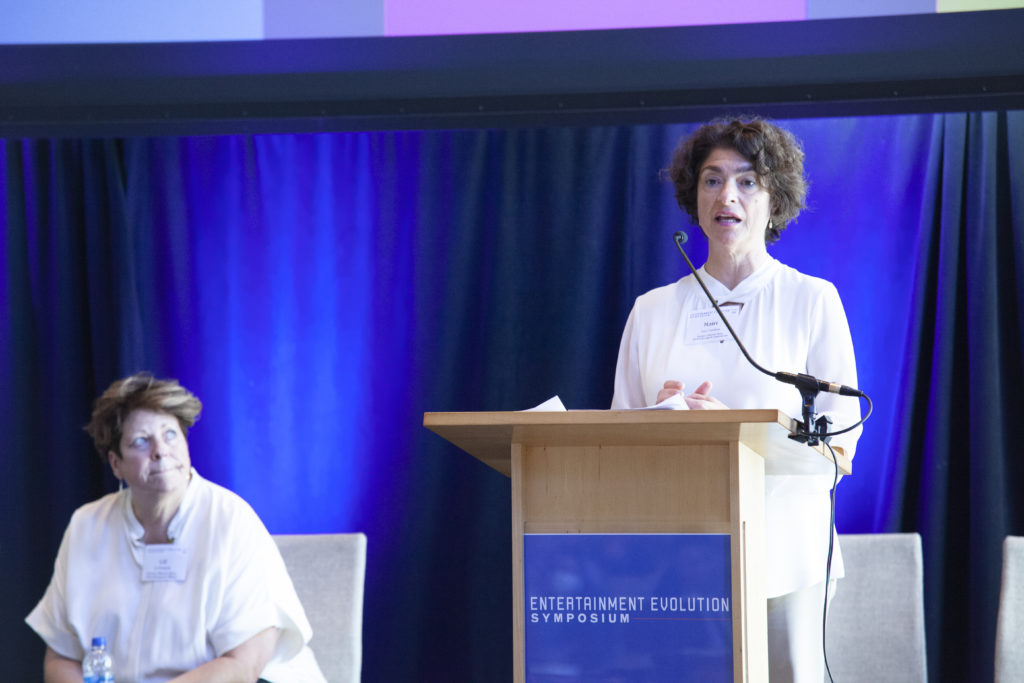
Industry Experts at EES: M&E Companies Must Evolve Business Models Amid Disruption
Several macro trends, along with the latest technological, generational and cultural shifts, stand to impact entertainment companies of the future, with implications for market direction, strategy and future business models, industry experts said Sept. 21 at the Entertainment Evolution Symposium (EES).
Nearly all brands, media companies, social media companies and video game companies are “facing disruption today,” Liz Huszarik, ex-EVP and chief research officer at Warner Bros. Entertainment, told attendees during the Consumers & Trends breakout session “Fan Touchpoints: Shifting Perspective on Consumers to Evolve Business Models & Unlock Value.”
“All of these players and then some are facing disruption [because] our fan, our consumer, our customer, they are now empowered and emboldened by technology,” she said. “And technology and their adoption of technology is driving this change. So all of us here, business leaders [and] people just entering their careers really must be ready because our future is now.”
When it comes to the expected next huge technologies – metaverse and Web 3.0 – “it really is the customer, consumer, fan [who] has control” and it is important to “ensure that we connect with them, engage with them, and delight them,” she added.
A Paradox About the M&E Industry
“The industry overall is growing but, paradoxically, many of the businesses, the segment businesses that participate in the industry, are struggling and they’re trying to find relevancy” as technology innovation drives “consumers to engage online,” according to Nairi Gardiner, ex-CFO at Warner Bros. Global Brands & Experiences.
 nThe technology innovation is “upending the distribution models like never before on all fronts,” Gardiner said.
nThe technology innovation is “upending the distribution models like never before on all fronts,” Gardiner said.
There are, however, some “no regret moves leaders should consider regardless of where they play, so that they can chart their path,” she said.
Quoting technologist Matthew Ball, she said, “an entertainment company really does three core things: They create and tell stories. They build love for those stories. And they monetize that love.” And that includes digital apps, films, theme parks, TV and video games, she added.
Social media, meanwhile, has become “table stakes for ongoing” fan engagement, she said.
Each of these companies has to manage its “own unique” business model, “either through an ownership model, a partnership model or a hybrid” model and then they have to “continuously engage their fans across the multiple touchpoints, which takes investment,” she noted.
“To be successful over the long haul, they have to be disciplined, they have to bring that holistic view of the economics for content development and make the trade-offs to optimize the distribution, the windowing and that requires a lot of coordination,” she told attendees.
“For most media companies, I can tell you from personal experience, this is a new muscle…. Figuring it out will be the winners: the ones that can get it right,” she added.
The 3 Big Step Changes
At a macro level, it’s the “advances in computing technology that have driven these commercial business shifts” over time, according to Gardiner. “And there have been three big step changes that have profoundly impacted all businesses, not just in our industry, over the last 70 years,” she said.
“In the 50s to 70s, [it was] mainframe computing,” she noted. Then, in the 80s to mid-2000s, “PCs and the internet interconnectivity and networking began” and that was followed by mobile and cloud computing, she said. The next generation will be led by the metaverse, she predicted.
When you look across all the “product evolutions and the capabilities, each period of tech innovation introduced new opportunities and products evolved and distribution capabilities evolved,” she noted.
Today, with mobile and cloud computing, it’s “not just changed sort of one industry or another; it’s changed our entire lives and the genie is out of the bottle,” she said.
After all, now “we’re able to do almost everything via the internet and mobile apps and, privacy issues aside, companies can access more data and gain more consumer insights than ever before, which they’re able to leverage and monetize in new ways,” she explained.
But all businesses, including entertainment, “have to figure out and embrace the digital transformation and they have to adapt and evolve or become irrelevant,” she warned.
“What’s really interesting in terms of a trend we see is now adoption of new is accelerating as consumers move online,” she pointed out. “So, for example, it took 26 years for TV to be in 25 percent of U.S. households [but] it only took 3.7 years for Alexa” to accomplish the same thing, she noted. “These factors shorten time to market and they pressure businesses to adapt quickly to stay in the game.”
She went on to say that, “since its inception, technology continues to challenge the status quo and our industry is no exception,” adding: “That pace is accelerating and many media companies are in secular decline. Tech is giving consumers access to high quality home entertainment systems, mobile devices like smartphones and tablets, internet access that connects them online to online platforms and social networks really on a global scale. And each of the segment businesses, especially within distribution, has been upended both creating and destroying value and forever changing the way money is made in our industry.”
The Shift to Home Viewing
Despite innovations in theater experiences, “the moviegoing audience has largely shifted to home viewing and you see that happen back in 2019-20, and it continues on into 2022,” according to Huszarik.
“So we’ve witnessed this really dramatic shift over the last five years in preference from going to the movies to watching a movie at home,” she said.
“Many of you may remember Friday night date night when you would go to a movie and get a bite either before or after the movie,” she said, taking a trip down memory lane. “Now we’ll watch a film at home with Uber Eats, or we’ll make a dinner that may be themed to align with the movie.”
Huszarik continues to “believe in the movie business but I believe it’s for those big events, big franchise films, the superhero, the fantasy, the sci-fi, the horror” now, she said, predicting: “It’s going to be harder and harder to launch IP that doesn’t have a brand name, that’s not a brand franchise.”
And that, she said, “really further illustrates the importance of brands and the importance of franchises.”
Meanwhile, “like film, the TV business is in secular decline as audiences shift to streaming,” she said. “I’m not saying it’s like a light switch [and] they’re going to be gone tomorrow but the data clearly illustrates it’s the older audience, the boomers that are propping up linear TV.”
Amid “times of these big secular shifts,” it is “imperative” that entertainment companies “stay connected to both the market and to develop … well-informed strategies but also stay connected to the consumer because they are evolving and changing and their habits are forming,” she added.
Business Implications Going Forward
Amid the various entertainment mediums, “the dogs include businesses like home video distribution that have reached the end of their life cycle as consumers no longer collect or rent physical DVDs,” according to Gardiner. “But let’s not forget, in their day, they’ve had an amazing run and they threw off a lot of profits for a lot of years. It’s just now it’s shifting.”
Meanwhile, the “question marks are businesses that still have some growth potential but do not operate within large markets so require more of a cautious investment strategy,” she said. An example would be companies that develop content for third parties. “Given competition for the broader companies to own their own streaming services, they would be potentially favoring their own content over acquiring content from a third party. So that’s a question mark,” she explained.
And the “cash cows are businesses like film exhibition and linear TV [because] they still are operating in large markets,” she said. Echoing Huszarik, she said: “They’re not lights off but the growth rate is in decline and so you would look how would you manage those businesses. You would [implement] strict cost management because revenues and cash flows are in decline.”
Key Takeaways
Huszarik summed up the session’s main takeaways. First, she said, each business should have a “clear understanding of [its] purpose.” They should also know their audiences.
Companies should also “be relentless about pursuing direct to consumer data” and “develop expertise to source and evaluate consumer and market trends and insights,” she said.
They should also understand their competition and “remember it’s not just your traditional competition” because media and entertainment companies are also competing against other businesses that account for a share of consumers’ money and time, she said.
And, “in addition to understanding that competition, you have to understand your consumer expectations around price to value and product offering,” she added.
She pointed to Netflix making a bet that if it lowers the price of its streaming service with a new ad model, it will be able to sign up new subscribers. However, she questioned “how many subs will just downgrade to the lower price” and whether the company will actually attract new subscribers as it intends.
It is also “really important to understand generational differences within your customer base [and] also within your workplace and what are those expectations and implications for you,” she said.
Her prediction: “Companies that understand that addressable audience inside and out can navigate and really have a bright future.”
Telling Connected Stories
Just as important now is “telling connected stories,” according to Gardiner, who said: “Fans want to know where they can find their characters and stories. And so building capabilities to tell those interconnected stories across all platforms is an advantage.”
She encouraged entertainment companies to “consolidate internal content development and marketing organizations.”
Companies must also be able to “build high performing teams that include multi-generational talent, especially talent that are digital natives,” she noted. “We learn from each other. And then you’ve got to keep your investments in technology and systems current.”
She added: “Focusing on this long game and making those difficult operational changes [that] disrupt the status quo … are not easy but that’s really where you’re going to create the long -term value for all stakeholders. And then, last but not least, [is the need to] prepare for the metaverse because it is coming. It will be the next generation internet. The difference is the internet as we know it was set up by academia [and] government invested. So there were sort of standards that we all then were able to leverage.”
Big questions for now are who will “build the metaverse” and “is it going to be built for commercial purposes only? What is that going to look like?” she said.
She predicted that building that infrastructure will “take years” but pointed out that some industry experts believe it “could create upwards of $3 trillion in new economies.”
However, it remains to be seen what companies and media are “going to get displaced as things start to shift,” she added. “That’s why you have to stay ahead of it. And trends and insights are so critical so that you can start to predict what that future looks like because everybody is moving more and more in this direction.”
Session attendees were able to walk away with some key considerations to help enable their organizations to win in the world of “Entertainment 3.0.”
The speakers were introduced by Nina Skorus-Neely, digital Advisor, media and entertainment transformation at Microsoft and secretary of Women in Technology: Hollywood (WiTH).
The Entertainment Evolution Symposium (EES) was presented by the Pepperdine Graziadio Business School Institute for Entertainment, Media and Sports (IEMS) and the Hollywood IT Society (HITS) and was sponsored by Iron Mountain, Signiant, Whip Media, Atos, Fortinet, FPT Software, invenioLSI, Perforce, Vision Media, and EIDR.
